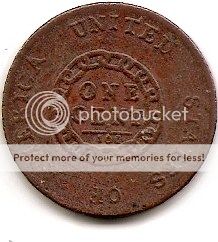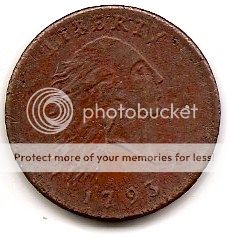1793 chain cent real on not
A customer wants to know if this is the real deal?
I have my ?,
The 9 in the date looks off.


the weight is 13.5 grams
Thank in advance
I have my ?,
The 9 in the date looks off.


the weight is 13.5 grams
Thank in advance
Pat Vetter,Mercury Dime registry set,1938 Proof set registry,Pat & BJ Coins:724-325-7211
0
Comments
60 years into this hobby and I'm still working on my Lincoln set!
looks suspicious.
really would like larger images. can't enlarge these without losing detail.
there are only 5 possibilities
can't be the NC, wrong position of liberty
not S-1 as that is the Ameri - variety
only comes close to matching S-2--------------------------
not S-3 wrong date position
not S-4 as wrong date position and no dot after 3
there are many features that seem right but it is the few that are off that makes this coin concerning.
i'm not going to go any further based on the images as it is too close to conjecture for such a possibly valuable coin. at this point i am 50/50
.
Worry is the interest you pay on a debt you may not owe.
"Paper money eventually returns to its intrinsic value---zero."----Voltaire
"Everything you say should be true, but not everything true should be said."----Voltaire
Check out some of my 1794 Large Cents on www.coingallery.org
<< <i>Its a Sheldon-2, but, as Bill Jones stated, its probably an electrotype. >>
When I first suggested that it might be an electrotype, I requested better pics including the edge. If it is an electrotype there should be a seam or evidence of a seam having been removed on the edge or at the juction where the edge meets the rim. In hand this coin wouldn't be that hard to evaluate but those pics are not that detailed. I'm heavily leaning toward calling this coin a fake.
Worry is the interest you pay on a debt you may not owe.
"Paper money eventually returns to its intrinsic value---zero."----Voltaire
"Everything you say should be true, but not everything true should be said."----Voltaire
I think he will be able to tell with the coin in hand.
<< <i>I thing I will take it to the PAN show in Oct. where Tom R. will be there.
I think he will be able to tell with the coin in hand. >>
What does the edge look like? Any evidence of a seam?
Worry is the interest you pay on a debt you may not owe.
"Paper money eventually returns to its intrinsic value---zero."----Voltaire
"Everything you say should be true, but not everything true should be said."----Voltaire
<< <i>
<< <i>I thing I will take it to the PAN show in Oct. where Tom R. will be there.
I think he will be able to tell with the coin in hand. >>
What does the edge look like? Any evidence of a seam? >>
Do not forget about the "drop in electros" that duplicate the real edge device with vines and bars.
<< <i>Do not forget about the "drop in electros" that duplicate the real edge device with vines and bars >>
I'm not familiar with those, Bill - do you have any more info about this?
<< <i>
<< <i>Do not forget about the "drop in electros" that duplicate the real edge device with vines and bars >>
I'm not familiar with those, Bill - do you have any more info about this? >>
As I alluded to in an earlier post, you need to also check the juncture of the rim and edge. One shell is a surface of the coin and the other shell is the other surface plus the complete edge. A real coin is pressed into wax and the impression is coated with a conductive powder such as graphite and this material is electroplated with copper to create a shell. Once the shells are completed they are fitted together with a lead or other base metal core and the seam is removed by polishing or electroplating to hide the seam.
Worry is the interest you pay on a debt you may not owe.
"Paper money eventually returns to its intrinsic value---zero."----Voltaire
"Everything you say should be true, but not everything true should be said."----Voltaire
I'd never heard that part before - thanks.
<< <i>ok, so that is where the 'drop in' comes from - fitting them together?
I'd never heard that part before - thanks. >>
That is correct. Electrotypes have been around for a long time and were even made by museums of their rare coins for collectors as replicas rather that any intent to fool anyone. Many were made as uniface examples to prevent deception by future owners. Some of the older electrotypes have collector value and sometimes appear in coin auctions as electrotypes. One of the best tests to check for an electrotype is the ring test. Since it wouldn't be struck from a solid planchet it will have a dull thud rather than a ring. Of course, an examination for a seam under high magnification is the best authentication technique.
Worry is the interest you pay on a debt you may not owe.
"Paper money eventually returns to its intrinsic value---zero."----Voltaire
"Everything you say should be true, but not everything true should be said."----Voltaire
<< <i>
<< <i>Do not forget about the "drop in electros" that duplicate the real edge device with vines and bars >>
I'm not familiar with those, Bill - do you have any more info about this? >>
The usual electrotype involves fitting two sides together with a base metal core to give the piece something close to the proper weight. These pieces will have a seam around the edge that might be removed. A "drop-in" electrotype has one side that is like a cup with the edge on it. The other side is mounted into the cup so that you can get the proper edge with no seam. The seam is around the outside of the surface area of the coin and easier to conceal.
There was a drop-in electrotype offered at an EAC auction four or five years ago that was offered as what it was, a copy. The piece was truly stunning, and it brought a very high price at the time, I think over $1,000. These things are very dangerous. Years ago I think PCGS got fooled on a Wreath cent of this type and had to buy it back. The Chain piece that I mentioned in the EAC auction was far, far more convincing than the piece that started this thread.